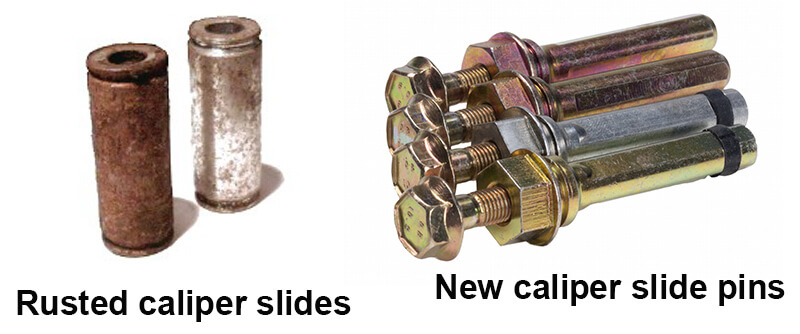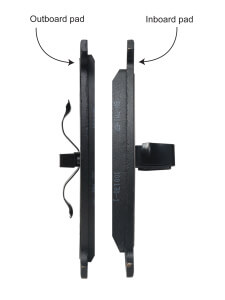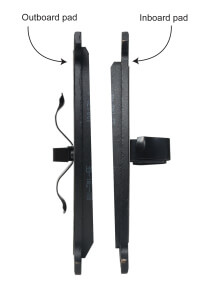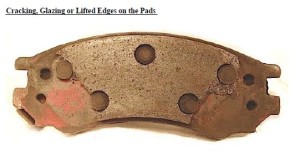Understanding Uneven Brake Pad Wear: Causes and Solutions
Learn the most common causes of uneven brake pad wear
Uuneven brake pad wear is a common issue that can lead to decreased braking performance, increased stopping distances, and potentially unsafe driving conditions. Understanding the most common causes of uneven brake pad wear can help diagnose and address the issue promptly. In this post, I’ll show you examples of uneven brake pad wear with an explanation of the root cause and how to avoid the problem in the first place.
A primer on brake pad nomenclature
The inboard pad sits next to the caliper piston. When you apply the brakes, the piston pushes the inboard pad against the rotor until it can’t be pushed any further. At that point, the pressure of the brake fluid forces the caliper body to move away from the rotor, pulling the outboard pad against the opposite side of the rotor.
The inboard brake pad is worn more than the outboard pad
The inboard pad will always wear a bit more than the outboard pad because it’s the first pad to contact the rotor. That’s normal wear. However, when the inboard brake pad is worn substantially more than the outboard pad, that’s not normal.
#1 Cause of inboard pad wear
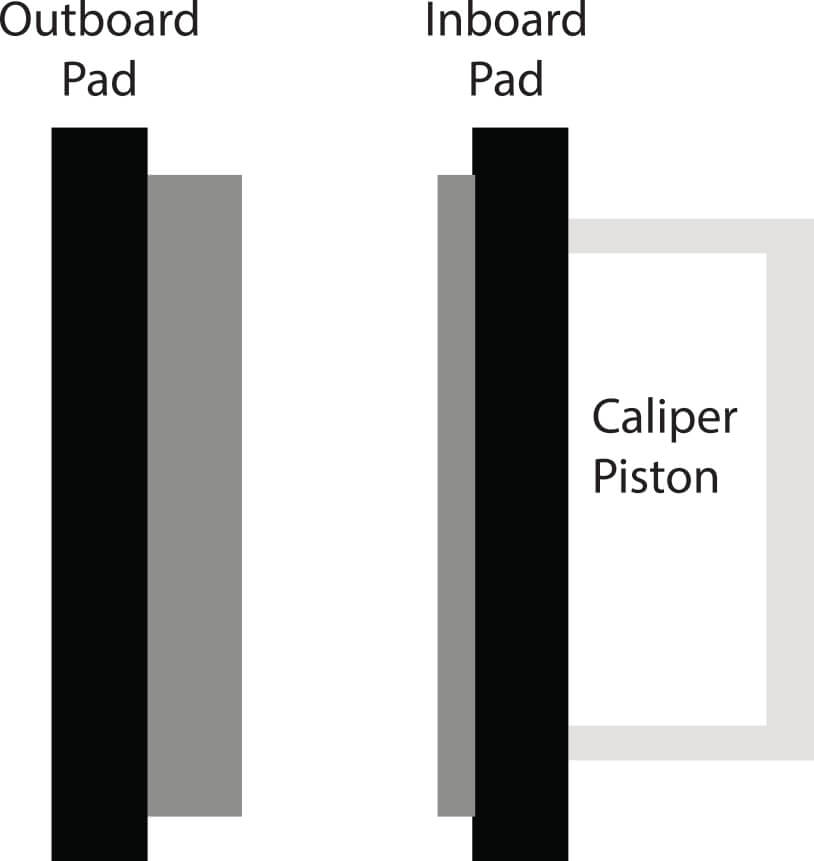 • The caliper slide pins are seized/binding, preventing the caliper from returning to its relaxed position and keeping the inboard pad in contact with the rotor. This is the most common cause.
• The caliper slide pins are seized/binding, preventing the caliper from returning to its relaxed position and keeping the inboard pad in contact with the rotor. This is the most common cause.
#2 Cause of inboard pad wear
• The pads are seized in the slide areas due to rust buildup. This is very common.
#3 Cause of inboard pad wear
• The caliper piston is not returning to its resting position caused by a hardened/binding square-cut O-ring in the caliper. So, the caliper piston stays extended and presses the inboard pad against the rotor. This can happen on old calipers, usually units that have over 150K miles on them.
#4 Cause of inboard pad wear
• The piston dust boot is torn or binding, or the caliper piston is corroded, preventing it from returning to the rest position. This is fairly rare.
#5 Cause of inboard pad wear
• The master cylinder or flexible brake hose maintains pressure on the fluid to the caliper. Check for residual brake pressure after releasing the brake pedal. This is very rare
How to fix inboard pad wear
1) Clean and grease the caliper slide pins— Remove and replace any corroded slide pins. Replace all rubber caliper pin boots and rubber pin sleeves (included with the boot kit). Clean out old lubricant. Apply new high-temperature brake lubricant to the pins before installation.
2) Clean and grease the pad abutment areas— Using a wire wheel and drill, remove rust from the pad slide areas on the abutment. Apply a thin film of dielectric high-temperature brake grease on the abutment BEFORE installing the new anti-rattle clips. The grease will slow down rust formation. Then, apply a very thin film of dielectric brake grease to the top of the anti-rattle clips
3) Check the condition of the caliper piston seal— If it’s torn, rebuild the caliper or install a rebuilt caliper.
The outboard pads are worn more than the inboard brake pad
The outboard brake pad stays in contact with the rotor and wears faster than the inboard pad.
#1 Cause of outboard brake pad wear
• Corroded or seized caliper slide pins— The caliper piston has relaxed and returned to its resting position, but the caliper body can’t release clamping pressure on the outboard pad due to corroded or seized caliper guide pins. This is a very common occurrence.
How to fix outboard pad wear
• Clean and lubricate the caliper guide pins with high-temperature synthetic brake grease. Replace corroded pins.
The brake pads show tapered wear
The following items can cause tapered pad wear:
#1 cause of tapered brake pad wear
The brake pad is binding in the abutment area. This is almost always caused by rust buildup on the caliper bracket or abutment, which prevents the brake pads from moving properly. The binding prevents one end of the brake pad from sliding and keeps the opposite side in contact with the rotor.
SOLUTION:
1) Remove the pads and check for corrosion on the ends of the pad backing plate. Clean corrosion off the abutment area with a wire brush and apply a light film of high-temperature brake grease to slow down future corrosion
2) Check for debris wedged in the pad slide area
3) With the rust removed, grease applied, new anti-rattle clips installed, check for proper pad movement in the slide. The pad should slide with slight force. Any binding is a problem. If it binds, now, it’ll seize later as the pads heat up. The steel backing plates on cheap brake pads are often out of spec and bind in the slides. Return them and get better pads. Don’t file the ends of the backing plates to make them slide easier. The filed areas will rust.
#2 Cause of tapered brake pad wear
Improper installation of the anti-rattle clips. Some anti-rattle clips are orientation-specific.

These anti-rattle clips are side-specific. If installed on the wrong side, they can cause the pad to bind and wear in a tapered pattern
Solution:
Match the orientation of the clips as you remove the old clips to ensure they go back in the right place
#3 Cause of tapered brake pad wear
One caliper guide pin is worn or seized or the rubber guide pin bushing has deteriorated. Either condition would cause the caliper to cock during application and apply uneven pressure to the pads.
SOLUTION:
Check the guide pins and rubber bushings for wear, corrosion, incorrect lube, or lack of lubrication. Replace cracked or deteriorated rubber bushings. Install new guide pins and lubricate with high-temperature synthetic brake grease.
The brake pad friction material is cracked
#1 cause of broken brake pad friction material — rusted backing plate
The most common cause of cracked or missing friction material is rusted, poor-quality backing plate steel, which breaks the adhesive bond between the friction material and the backing plate.
When steel corrodes, the rust blooms expand and exert outward pressure on the friction material. The friction material is glued to the backing plate and cannot withstand the pressure. So, it is “rust jacked” away from the backing plate. Once that happens, brake pressure causes the friction material to crack and fall off.
For more information on steel backing plates, see this post
#2 cause of broken brake pad friction material — backing plate flex
The second most common reason for broken or missing friction material is a cheap steel backing plate that flexes during braking. Cheap brake pads are made of inexpensive steel backing plates that are too thin for the application. Since pressure is only applied to the center of the backing plate, the outer edges flex, causing the friction material to crack off.
#3 Cause of broken friction material — overheating
The third most common cause of this condition is thermal distress caused by improper installation, driver overuse of brakes, residual pressure in the hydraulic system, or improper adjustment or operation of the parking brake.
Backing plate corrosion
Corrosion on the backing plate has destroyed the glue bond between the plate and the friction material and the “rust jacking” has lifted the friction material up from the plate, where it breaks off. Buy better quality brake pads.
>Backing plate flex
The backing plate is too thin for the application and has flexed while braking, causing the edges to lift off the backing plate and break off. Buy better-quality brake pads
©, 2015 Rick Muscoplat
Posted on by Rick Muscoplat
